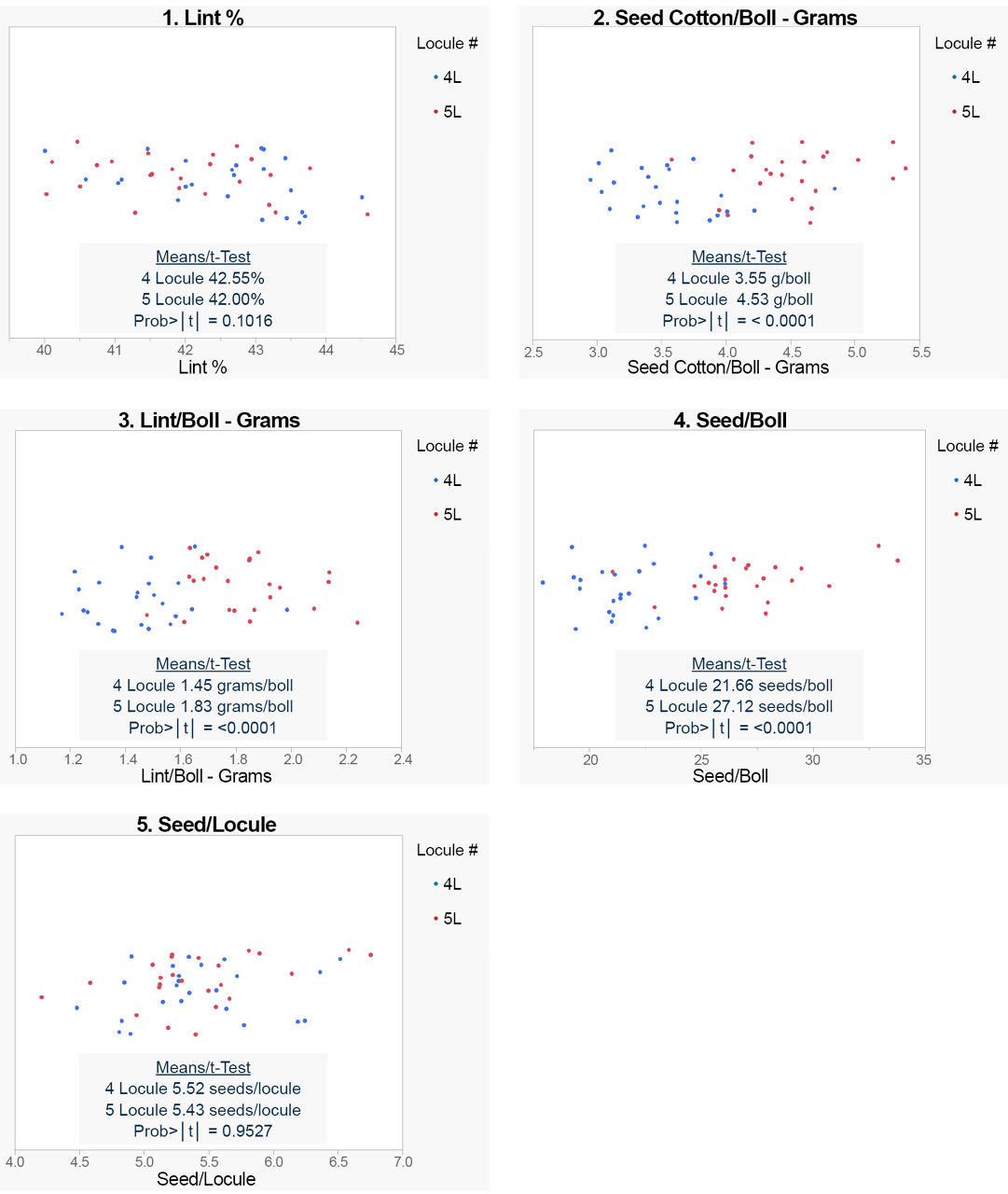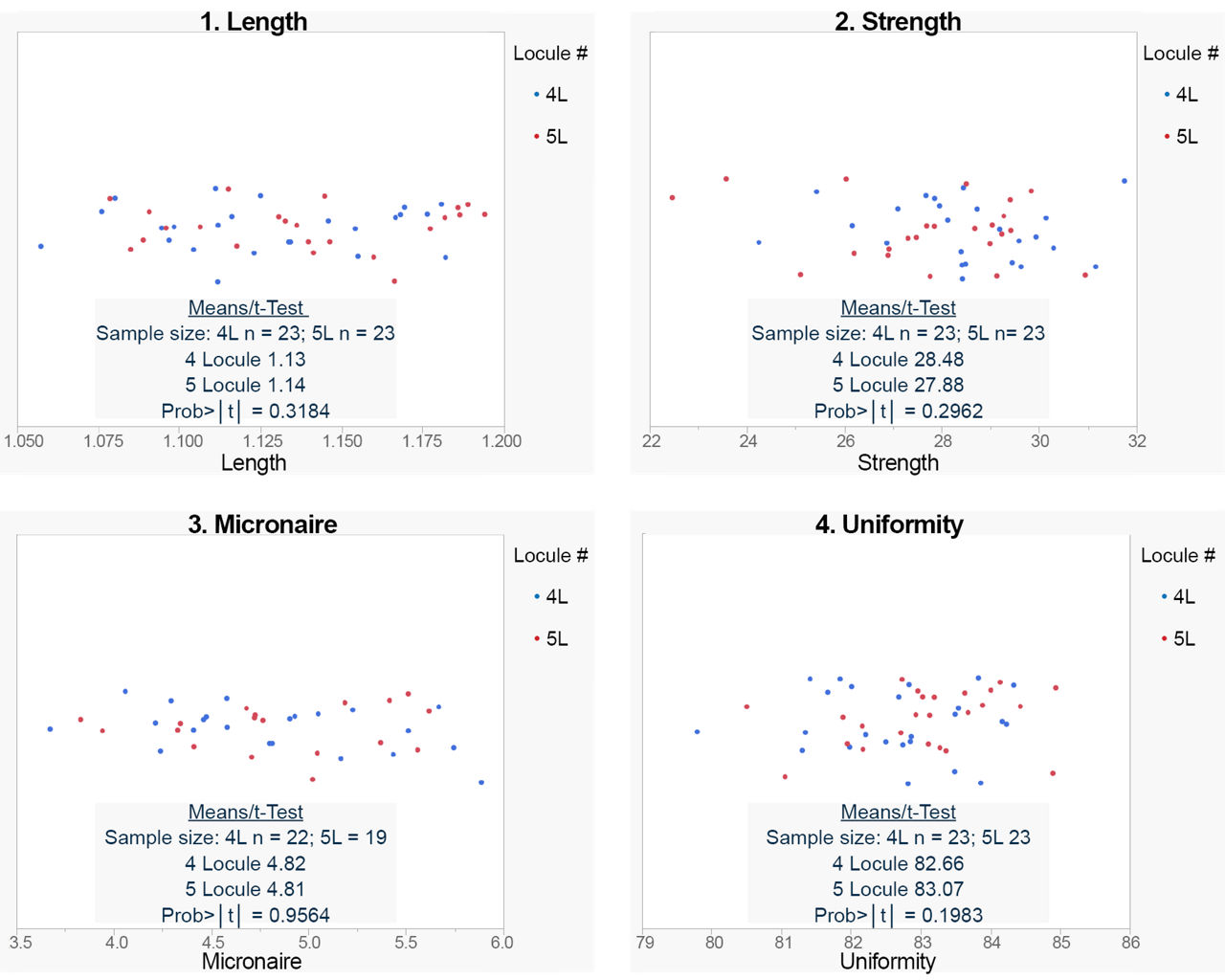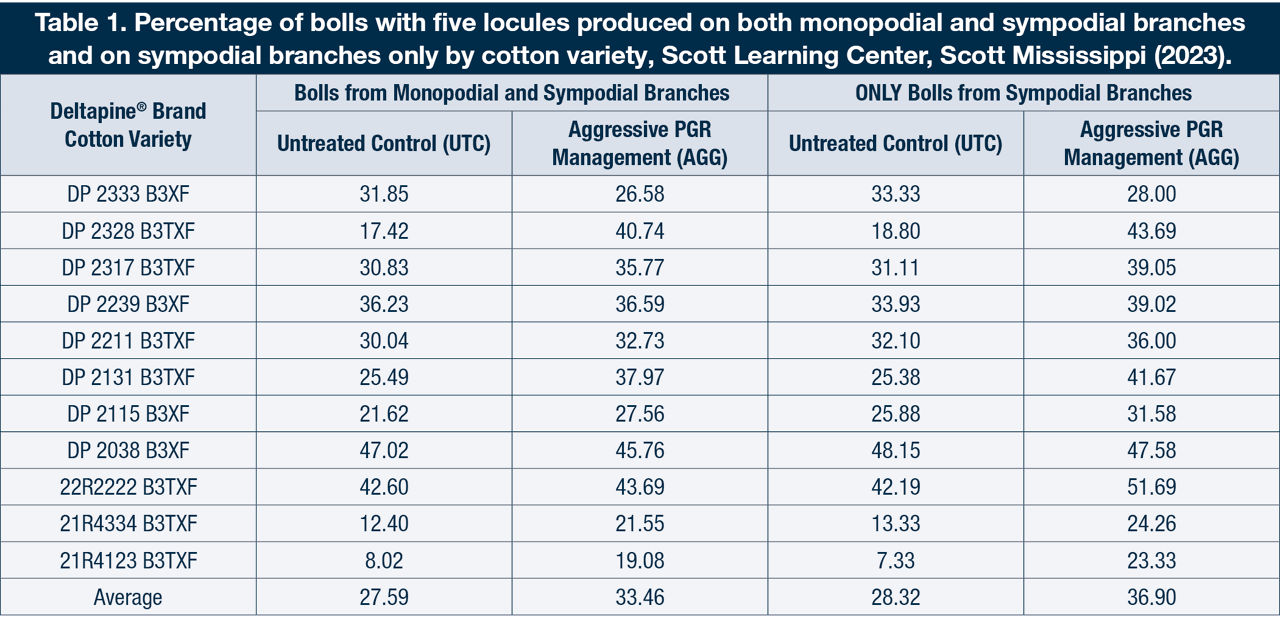Does Plant Growth Regulator Use Impact Boll Size and Locule Number in Cotton?
March 3, 2024
TRIAL OBJECTIVE
- Over the last several seasons, the Scott Learning Center has evaluated the impacts of plant growth regulator (PGR) use, plant spacing, seeding rate, and variety selection on cotton boll size, development, and locule number. Data from these studies have indicated that the number of locules that a cotton boll develops can be influenced by many these factors, and that bolls with five locules tend to have higher seed cotton weight, lint weight, and seed quantity than four locule bolls.
- This work has been continued in 2023, with the SLC staff positionally mapping 11 cotton varieties to document yield accumulation, locule numbers, and additional important characteristics associated with cotton boll development.
- This data can be one component to help explain the effects plant growth regulators can have in cotton and the compensatory ability of cotton plants in regard to changes in boll size/weight.
RESEARCH SITE DETAILS

- There were 12 Deltapine® brand cotton varieties planted in this trial:
- DP 2211 B3TXF
- DP 2115 B3XF
- DP 2317 B3TXF
- 22R2222 B2TXF*
- 21R4123B3TXF*
- DP 2328 B3TXF
- DP 2131 B3TXF
- DP 2333 B3XF
- 21R4334 B3TXF*
- DP 2038 B3XF
- DP 2239 B3XF
- This trial included three of the New Product Evaluator (NPE) varieties tested during 2023 (see asterisks). These products were not advanced but have been included in this study as they provide additional data points to support the cotton physiology objective of this dataset.
- Plant growth regulator (PGR) treatments included:
- Untreated control (UTC)
- Aggressive (AGG) PGR management with 4.2% mepiquat applied at the following timing:
- 6/20/2023: 16 fl oz/acre at 7 nodes
- 7/6/2023: 16 fl oz/acre at 12 nodes
- 7/17/2023: 16 fl oz/acre at 15 nodes
- The trial was planted into a field with 140 lb nitrogen (N) surface applied as 30-0-0-2.5 prior to layby.
- Each treatment was planted as a 6-row strip trial with 0.17 to 0.21 acres per plot.
- All field work, tillage, and herbicide applications were per local standards.

Positional Mapping
- The Boll-O-Meter (Figure 1) was used to document fruiting profile and accumulation for each cotton variety by PGR application.
- Six row feet per plot were mapped using the Learning Center standard protocol.
- Data were assimilated post-mapping for analysis.
- Seed cotton samples were weighed, ginned, and delinted into cohorts for each locule treatment. After mapping each variety/PGR combination, bolls were bulked as follows into the following cohorts:
- 4 Locule Bolls
- 5 Locule Bolls
- Fiber quality and turnout were derived from these samples for the various parameters.
Trial Analysis
- Cotton variety was held as replicate (n=11) and PGR Treatment as main effect (n=2).
- Standard Least Square Mean ANOVA performed via JMP to establish statistical differences.
- In the event of statistical significance (p < 0.05) means were separated using Fisher’s protected LSD.
- Comparisons between four and five locule samples (seed, weight, and fiber properties) were made using Student’s t-test and reported when significantly different at p < 0.05.
UNDERSTANDING THE RESULTS
A total of 3869 cotton bolls were mapped in 2023 across all treatments and fruit types. Of the bolls mapped, 69% (2664) of the bolls were four locule and 31% (1205) were five locule.
Boll Size – Bulk estimations across both four and five locule bolls; this is across bolls produced on both sympodial and monopodial branches.
- Seed cotton per boll – Aggressive PGR use generated significantly heavier bolls (data not shown).
- AGG: 3.98 grams seed cotton/boll
- UTC: 3.66 grams seed cotton/boll
- P = 0.0350
- LSD = 0.27
- Lint per boll – Aggressive PGR use generated significantly heavier bolls (Figure #, panel #/data not shown).
- AGG 1.69 grams lint cotton/boll
- UTC 1.56 grams lint cotton/boll
- P = 0.0414
- LSD = 0.12
PGR Influence on Locule Number
- Across all bolls produced (both monopodial and sympodial bolls)
- Percent of bolls with five locules (Table 1):
- AGG = 33.46%
- UTC = 27.59%
- P = 0.0534
- LSD = 5.69
- Weight contribution of five locule bolls to total weight (Table 2):
- AGG = 38.94%
- UTC = 32.57%
- P = 0.0880
- LSD = NS
- Percent of bolls with five locules (Table 1):
- Sympodial bolls only
- Percent of bolls with five locules (Table 1):
- AGG = 36.90%
- UTC = 28.32%
- P = 0.0111
- LSD = 6.01
- Weight contribution of five locule bolls to total weight (Table 2):
- AGG = 42.54%
- UTC = 33.78%
- P = 0.0189
- LSD = 7.23
- Percent of bolls with five locules (Table 1):

- Observations on Lint Percent, Boll Weight and Seed Parameters. A non-paired, two tailed t-test (P<0.05) was used to compare the populations of the boll types across the entire experiment.
- Lint percent (Figure 2, Panel 1)
- Four locule bolls: 42.55%
- Five locule bolls: 42.00%
- Prob>│t│ = 0.1016
- Four and five locule boll data indicated statistically similar turnout.
- Seed cotton per boll (Figure 2, Panel 2)
- Four locule bolls: 3.55 g/boll
- Five locule bolls: 4.53 g/boll
- Prob>│t│ = < 0.0001
- Bolls with five locules weighed significantly more (27.6% more) than four locule bolls.
- Lint per boll (Figure 2, Panel 3)
- Four locule bolls: 1.45 grams/boll
- Five locule bolls: 1.83 grams/boll
- Prob>│t│ = <0.0001
- Bolls with five locules produced significantly more (26.2% more) lint than four locule bolls.
- Delinted seeds per boll (Figure 2, Panel 4)
- Four locule bolls: 21.66 seeds/boll
- Five locule bolls: 27.12 seeds/boll
- Prob>│t│ = <0.0001
- Five locule bolls produced significantly higher (25.2% more) numbers of seeds per boll.
- Seeds per locule (Figure 2, Panel 5)
- Four locule bolls: 5.52 seeds/locule
- Five locule bolls: 5.43 seeds/locule
- Prob>│t│ = 0.9527
- Four locule and five locule bolls contained statistically similar numbers of seeds per locule.
- Lint percent (Figure 2, Panel 1)
- Fiber Quality Testing – A few samples were either lost in laboratory sampling or not large enough to perform High Volume Instrument (HVI) testing. Therefore, data sample numbers vary. Sample sizes are listed below.

- Fiber Length (Figure 3, Panel 1) – (Sample size number: 4L = 23; 5L = 23)
- Four locule bolls: 1.13 inches
- Five locule bolls: 1.14 inches
- Prob>│t│ = 0.3184
- Four and five locule bolls had statistically similar fiber length.
- Fiber Strength (Figure 3, Panel 2) – (Sample size number: 4L = 23; 5L = 23)
- Four locule bolls: 28.48
- Five locule bolls: 27.88
- Prob>│t│ = 0.2962
- Four and five locule bolls had statistically similar fiber strength.
- Micronaire (Figure 3, Panel 3) – (Sample size number: 4L = 22; 5L = 19)
- Four locule bolls: 4.82
- Five locule bolls: 4.81
- Prob>│t│ = 0.9564
- Four and five locule bolls had statistically similar micronaire.
- Uniformity (Figure 4, Panel 4) – (Sample size number: 4L = 23; 5L = 23)
- Four locule bolls: 82.66
- Five locule bolls: 83.07
- Prob>│t│ = 0.1983
- Four and five locule bolls had statistically similar uniformity.


KEY LEARNINGS
- When considering both boll types as individual populations, aggressive PGR use generated significantly heavier bolls both in seed cotton weight and lint weight per boll.
- In this trial, aggressive PGR management significantly increased the percentage of bolls with five locules. This was particularly true for bolls produced on sympodial structures.
- Five locule bolls across this study contributed disproportionally (6 to 8% more) to the yield of these mapped plants than four locule bolls. This was true in both aggressively managed and UTC treatments and was particularly true when considering sympodial bolls alone.
- Five locule bolls produced significantly more delinted seeds per boll than four locule bolls.
- Four and five locule bolls produced similar numbers of delinted seeds per locule.
- Four and five locule bolls had similar fiber length, strength, micronaire, and uniformity.
- Cotton varieties have different responses to PGR in many parameters. Locule number determination is no different, in that some varieties produce more five locule bolls inherently and some respond differently to PGRs.
- Previous data generated by the Scott Learning Center indicated that seeding rate, plant spacing, and cotton variety can influence the production of five locule bolls. Current data additionally suggests PGR use can also influence five locule boll production.
- This should not be viewed as a management technique, but rather as further understanding of ongoing observations from many cotton production environments.
- Please contact your local Deltapine® brand representative for more information.
1414_347700
Seed Brands & Traits
Crop Protection
Disclaimer
Always read and follow pesticide label directions, insect resistance management requirements (where applicable), and grain marketing and all other stewardship practices.
©2024 Bayer Group. All rights reserved.